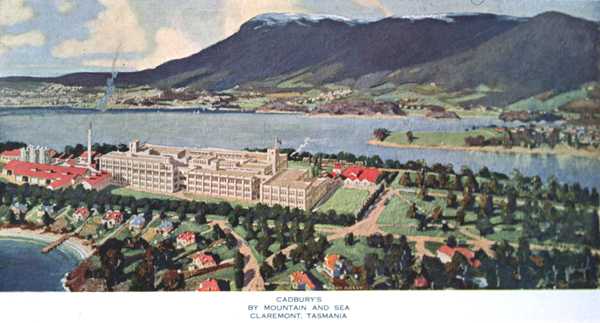 |
 |
|
Cadbury
The chocolate house of Cadbury was founded in Birmingham, England in 1830 and began exports to Australia in 1881. After the First World War a period of global expansion began and it was decided to establish manufacturing in Australia. A Commission was dispatched to find a suitable site and visited Melbourne and Sydney before a chance meeting with the Tasmanian Premier, Sir Walter Lee, saw members travel to Hobart. Here they found an eager workforce, plentiful electricity, international and interstate shipping and a cooler climate. They were able to purchase a site at Claremont which would enable them to develop an antipodean version of the Bournville 'factory in a garden' – the Quaker vision for modern industry. In 1921 construction commenced on the 100-hectare River Derwent peninsula 13 kilometres north of Hobart. An official opening took place on 21 October and production commenced in January 1922 under the leadership of expatriate confectioners from England. They settled in the adjacent garden suburb, blessed with a school, playing fields and the river's coves and beaches. Several members of the original Commission stayed on as directors of the local board and built fine homes in the district. Meanwhile Cadbury had developed a unique process for making milk chocolate, and production of the famous Dairy Milk Chocolate commenced at Claremont in 1928. After a difficult period through the Depression and the Second World War, Cadbury has flourished. A consistent policy of product development and technical investment sustained its competitive position until today it is the pre-eminent confectionery company in Australia. Other factories were acquired in Melbourne, and the company headquarters were moved there in 1971 to be closer to larger markets and key customers. Claremont has focused its production activity on moulded chocolate blocks, boxed assortments such as Favourites, Milk Tray and Roses, chocolate bars like Flake and Turkish Delight, Bournville Cocoa and the supply of Dairy Milk Chocolate to other factories. Recent investments in modern moulding and packaging equipment featuring robotics have been at the leading edge of technology and have given many staff overseas experience in the search for industry 'best practice'. From a base established in 1948, a modern milk-processing factory has been developed near Burnie in Tasmania's rich north-western dairy country. It now processes some 15 percent of the state's milk output for Dairy Milk production. Tankers transport the milk south to Hobart. Claremont retains the Company's 'the jewel in the crown' status. Cadbury is one of the largest private employers in Tasmania. It has been able to achieve an ideal pattern of productivity improvement, essential in a very competitive Australian confectionery market, coupled with growth in demand sustaining a steady level of employment and a workforce of undoubted skill, experience and loyalty. Today Claremont is not only a state-of-the-art manufacturing operation but also a major tourist attraction with more than 150,000 visitors each year. The Company has had a long history of community involvement through support for local groups, including charities and schools, and valuable sponsorship of events throughout the state. Further reading: A Gardiner, The life of George Cadbury, London, 1923; E Barringer, Sweet success, New Zealand, 2000. Ted Best |
Copyright 2006, Centre for Tasmanian Historical Studies |
